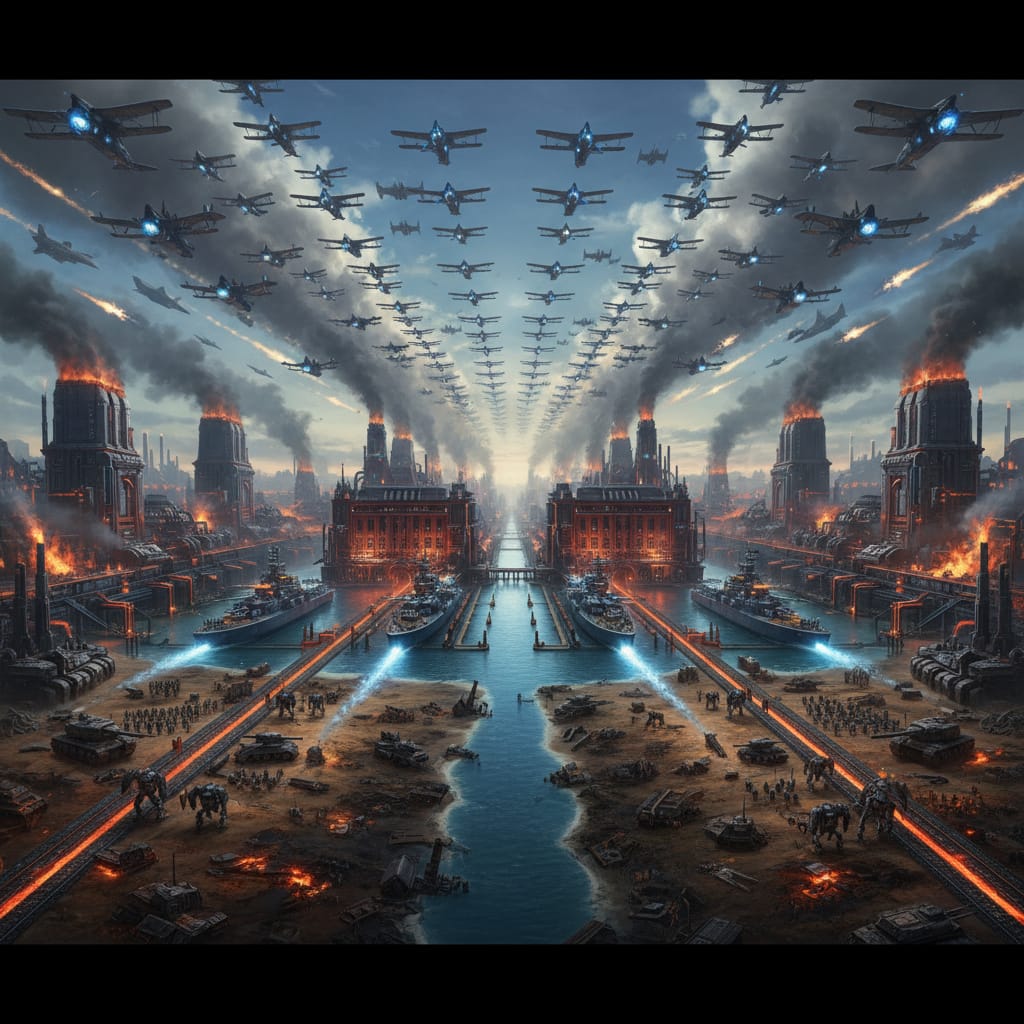The Venetian Arsenal stands as one of the most specialized, yet potentially game-breaking, wonders in Civilization 6. Its effect is simple and profound: every time you train a naval unit, you get a second one for free. This wonder has been the cornerstone of many a naval domination victory, allowing players to amass an armada at a speed no other civilization can hope to match. But what if this powerful bonus wasn’t confined to the seas? What if the Venetian Arsenal’s “buy one, get one free” offer extended to the barracks and the airfield? This analysis delves into the strategic and tactical implications of such a change, exploring how it would reshape the very foundations of warfare and empire-building in Civilization 6.
The New Era of Land Warfare: A Juggernaut Unleashed
Applying the Venetian Arsenal’s bonus to land units would fundamentally alter the calculus of military production. The ability to produce two land units for the price of one would create an unprecedented force multiplier, turning any civilization with this wonder into a military juggernaut.
Early Game Rush: A Double-Edged Sword
In the early game, the impact would be immediate and dramatic. A player who manages to construct the Venetian Arsenal would be able to churn out warriors, slingers, and archers at a staggering rate. A city with a respectable production of 10-15 could field a new pair of units every few turns. This would make early-game rushes not just viable, but overwhelmingly powerful.
- The Archer Swarm: The community often discusses the “archer swarm” as a potent early-game strategy. With the Venetian Arsenal, this would be taken to a whole new level. A player could produce two archers for the production cost of one, creating a defensive line or an offensive force that could overwhelm opponents through sheer numbers.
- The Warrior Flood: While less sophisticated, the ability to generate two warriors at a time would be a terrifying prospect for any neighbor. A civilization with this bonus could simply flood the map with cheap, effective units, crippling an opponent’s development before they have a chance to build walls or field more advanced troops.
However, this strategy comes with a significant drawback: unit maintenance. An army of this size would be a massive drain on the treasury. Without a robust economy to support it, a player could quickly find themselves bankrupt, leading to a decline in science and culture output. The forums are filled with cautionary tales of players who overextended their military in the early game and paid the price in the long run.
Mid-Game Dominance: The Rise of the Corps and Armies
As the game progresses into the medieval and renaissance eras, the Venetian Arsenal’s bonus would become even more potent. The ability to form corps and armies is a key component of mid to late-game warfare, and this wonder would make it laughably easy.
- Instant Corps: A player could produce two of the same unit and immediately combine them into a corps. This would effectively mean that for the production cost of a single unit, you are getting a +10 combat strength bonus. This is a massive advantage that would allow a player to field an army of elite units far earlier than their opponents.
- Unstoppable Armies: The same principle applies to armies. By the time a player unlocks the ability to form armies, they could be producing two units at a time and combining them into a three-unit powerhouse. An army of knights or musketmen with this advantage would be nearly unstoppable, capable of steamrolling through even the most heavily fortified cities.
Many professional gamers suggest that the key to a successful mid-game is timing. The Venetian Arsenal would allow a player to create a “timing push” of unprecedented power. An army of corps and armies, fielded a dozen turns before an opponent can respond in kind, would be a game-ending advantage.
Late Game Annihilation: The Modern Armor Onslaught
In the late game, the Venetian Arsenal’s bonus would reach its terrifying zenith. The production of modern armor, mechanized infantry, and artillery would be doubled, allowing a player to create an unstoppable modern military machine.
- The Tank Factory: A city with high production could be churning out two tanks every few turns. This would allow a player to create a massive armored division that could blitz through enemy territory with impunity.
- The Artillery Barrage: The ability to produce two artillery units at a time would make siege warfare a trivial affair. A player could create a line of artillery that would reduce a city’s defenses to rubble in a matter of turns.
Analysis on forums shows that the late game often becomes a stalemate, with players hunkering down behind powerful defenses. The Venetian Arsenal would shatter this stalemate, allowing a player to create an offensive force that could break through any defensive line.
The Air Force of a Superpower: Ruling the Skies
The application of the Venetian Arsenal’s bonus to air units would be just as transformative as its effect on land units. The ability to produce two air units for the price of one would give a player complete and utter air superiority, with all the strategic advantages that come with it.
Early Air Power: The Biplane Revolution
The first air units, biplanes, are often overlooked. They are fragile and have limited range. However, with the Venetian Arsenal, a player could produce them in such numbers that they become a viable and even powerful force.
- The Reconnaissance Network: A swarm of biplanes could be used to create a comprehensive reconnaissance network, giving a player complete visibility of the map. This information advantage would be invaluable for planning military campaigns and identifying strategic targets.
- The Harassing Force: While a single biplane is not a major threat, a dozen of them can be a significant nuisance. They can be used to pillage enemy improvements, harass enemy units, and even provide a small amount of air support in combat.
A popular strategy is to use early air power to disrupt an opponent’s economy. With the Venetian Arsenal, a player could create a force of biplanes that could systematically dismantle an opponent’s infrastructure, crippling their ability to wage war.
The Fighter Sweep: Unchallenged Air Superiority
As the game progresses to fighters and bombers, the Venetian Arsenal’s bonus would become a game-winning advantage. A player could produce a fighter screen of such density that no enemy aircraft could hope to penetrate it.
- The Unbreakable Shield: With two fighters being produced for the cost of one, a player could create a permanent fighter patrol over their territory. This would make them immune to enemy air attacks, giving them a massive defensive advantage.
- The Decisive Sweep: On the offensive, a player could use their overwhelming number of fighters to sweep the skies of enemy aircraft. This would give their bombers free rein to attack enemy cities and units, leading to a swift and decisive victory.
According to the player community, achieving air superiority is one of the most important objectives in modern warfare. The Venetian Arsenal would make this objective a triviality, giving a player a massive strategic advantage.
The Bomber Fleet: Rain of Destruction
The true power of a Venetian Arsenal-boosted air force would be seen in its bomber fleet. The ability to produce two bombers for the price of one would allow a player to create a fleet of such size and power that it could level entire civilizations in a matter of turns.
- The Strategic Bombing Campaign: A player could use their massive bomber fleet to systematically destroy an opponent’s infrastructure. They could target industrial zones to cripple their production, commercial hubs to bankrupt their economy, and campuses to halt their scientific progress.
- The Tactical Annihilation: In a direct military confrontation, a fleet of bombers could be used to annihilate an enemy army before it even reaches the front lines. A wave of bombers could turn a tank column into a smoldering wreck, or a line of infantry into a cratered field.
Analysis on forums shows that the late-game often revolves around the use of nuclear weapons. A player with a Venetian Arsenal-boosted bomber fleet would have a much more conventional, and arguably more effective, means of achieving total victory.
The Ripple Effect: Reshaping the Entire Game
The impact of this change would not be limited to the battlefield. The Venetian Arsenal’s bonus, applied to land and air units, would send ripples throughout every aspect of the game, from diplomacy to city management.
The Diplomatic Game: A New World Order
A civilization with this wonder would be a diplomatic powerhouse. Other civilizations would be forced to treat them with a mixture of fear and respect.
- The Ultimate Deterrent: The sheer military potential of a Venetian Arsenal-boosted civilization would be a powerful deterrent. Other civilizations would be hesitant to declare war, knowing that they would be facing an army of overwhelming size and power.
- The Unbalanced Alliance: Alliances would be heavily skewed in favor of the Venetian Arsenal civilization. They would be the senior partner in any military alliance, able to dictate the terms of engagement and call upon their allies to support their campaigns.
The Economic Equation: A Double-Edged Sword
The economic implications of this change would be complex. While the production bonus is incredibly powerful, the cost of maintaining a massive army would be a significant challenge.
- The Gold Sink: A player would need a robust economy to support their massive army. They would need to prioritize commercial hubs, harbors, and trade routes to generate the necessary income.
- The Production Powerhouse: On the other hand, the ability to produce two units for the price of one would free up production for other purposes. A player could use this to build up their infrastructure, wonders, and districts, creating a well-rounded and powerful empire.
The Victory Condition Race: A Military Steamroll
This change would make a domination victory the most likely, and arguably the easiest, victory condition. However, it would also have an impact on other victory conditions.
- The Science Victory: A player could use their military superiority to protect their scientific endeavors. They could conquer rival civilizations to eliminate competition, or simply use their army as a deterrent to prevent other players from interfering with their space race.
- The Culture Victory: A powerful military can be a surprisingly effective tool for a culture victory. A player could use their army to conquer cities with great works of art and artifacts, or to “persuade” other civilizations to adopt their culture.
A Game of Unprecedented Power
The hypothetical application of the Venetian Arsenal’s bonus to land and air units presents a fascinating thought experiment. It is a change that would fundamentally reshape the strategic landscape of Civilization 6, creating a military powerhouse of unprecedented scale and power. The early game would be defined by overwhelming rushes, the mid-game by the rapid formation of corps and armies, and the late game by the deployment of an unstoppable modern military machine. The skies would be ruled by a superpower, and the diplomatic table would be dominated by a single, unchallengeable force. While the economic challenges would be significant, the sheer military advantage offered by this change would be a game-winning one. It is a change that would turn Civilization 6 into a game of ultimate power, where the player who builds the Venetian Arsenal holds the fate of the world in their hands.


